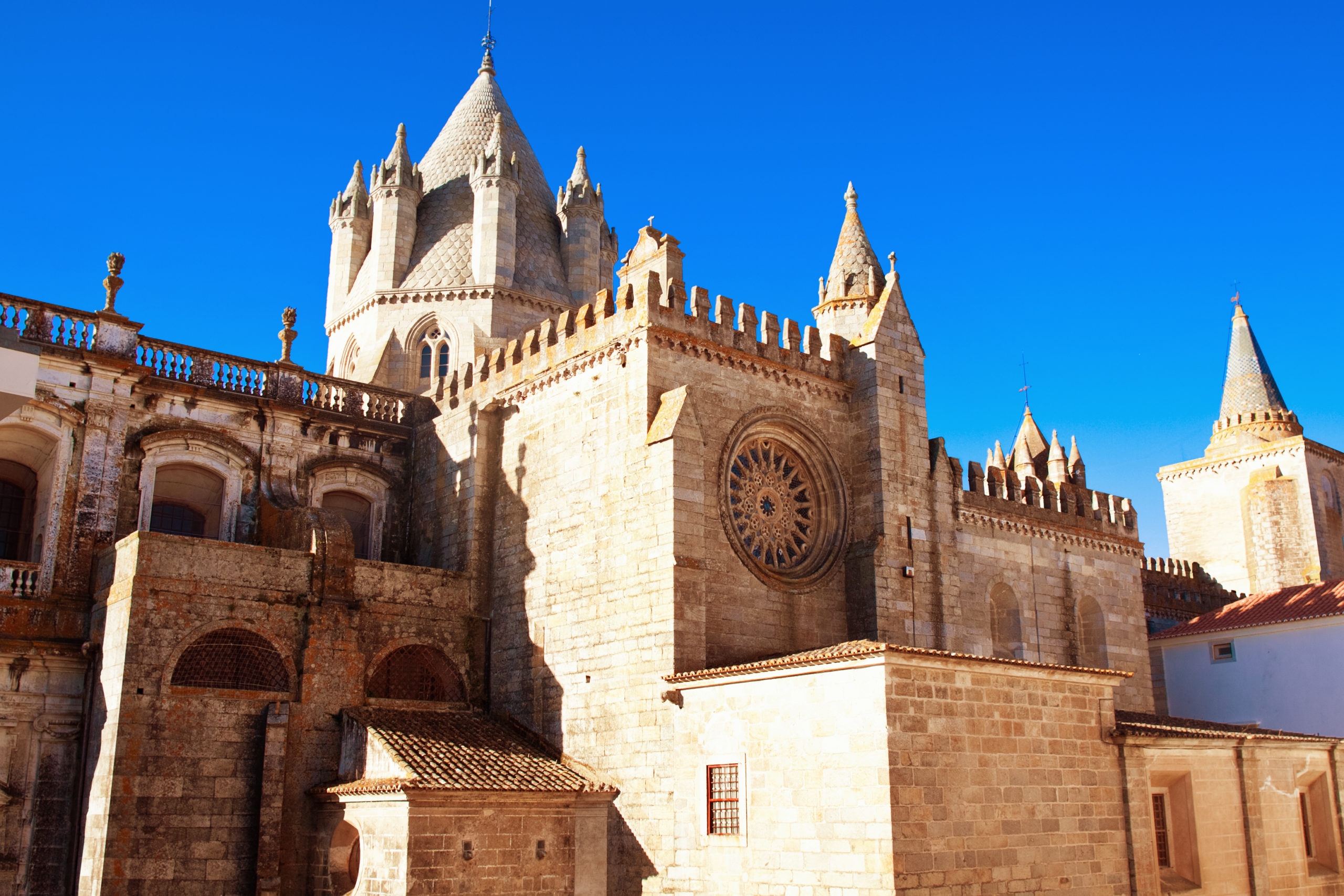Évora feels like those university towns that slow down in summer and come alive in September. Except here, students mingle with 2,000 years of Roman history and an intact medieval centre. The capital of Alentejo draws visitors for its Roman temple planted right in the city centre and its chapel lined with human bones. Portuguese visitors come for the regional wines and local cuisine, whilst foreign tourists tick off another UNESCO site from their list.
The Fortified Historic Centre
Évora’s medieval walls still encircle the old town across 3 kilometres. Unlike other Portuguese fortified cities, there’s no exhausting climb here – the historic centre remains relatively flat, manageable even in 40°C (104°F) summer heat (yes, it can get scorching in Évora). Praça do Giraldo serves as the nerve centre with its arcades, Renaissance fountain, and café terraces where prices double the moment you sit down.
Cobbled streets radiate from the square like spokes. White façades with yellow or blue trim follow the Alentejo colour code. Some houses still display their original azulejo tiles, others have sold them to antique dealers. The Mouraria quarter preserves its Arabic layout: narrow alleys, vaulted passages, hidden small squares. Tourists get lost here systematically, GPS struggles to connect between the thick walls.
The university occupies a good quarter of the centre since the 16th century. The historic buildings can be visited, but students prefer the bars on Rua 5 de Outubro. The contrast works: traditional black capes on exam days, Erasmus parties the rest of the year.
Roman Remains in the Modern City
The Temple of Diana stands in the middle of Évora as if nothing had happened. Its 14 Corinthian columns survived because it was turned into a slaughterhouse in the Middle Ages, then a timber depot. Irony saved the monument. Today, tourists photograph its granite columns from every angle whilst sixth-formers revise sitting on the steps.
The Roman baths can be visited beneath the town hall, entrance through a discreet door that’s easily missed. The underground route shows the underfloor heating systems, circular rooms, and mosaic remains. Modern lighting and explanatory panels compensate for the lack of spectacle. Archaeology enthusiasts appreciate it, others emerge within five minutes.
The Água de Prata aqueduct runs 9 kilometres into the city centre. Houses have been built between its arches, transforming the Roman structure into an aerial street. The walk along the aqueduct is worthwhile to escape the standard tourist circuits. The sections in open countryside offer the best photos, without cars parked beneath the arches.

Churches and the Capela dos Ossos
Évora Cathedral blends Romanesque, Gothic and Baroque according to its construction periods. The cloister remains the most photogenic part with its orange trees. The climb to the roof terrace is tiring but the panoramic view over Alentejo justifies the effort and additional charge. Religious services continue; tourists in shorts get turned away during mass.
The Capela dos Ossos draws crowds in São Francisco church. Franciscan monks lined the walls and columns with bones from 5,000 bodies exhumed from medieval cemeteries. Skulls and femurs form geometric patterns beneath the motto “We bones who are here await yours”. The macabre effect works, enhanced by dim lighting and musty smell. Some find it fascinating, others emerge feeling queasy. Children alternate between terror and fits of giggles.
The Graça church displays baroque atlantes on its façade, four stone giants supporting globes. Locals call them “the children of Graça”, tourists seek the best Instagram angle. Inside, azulejos tell biblical scenes, but the church only opens intermittently.
Where to Eat and Sleep in Évora
Accommodation concentrates around the historic centre. Pousadas and boutique hotels occupy former convents or palaces, with prices to match. Guesthouses in traditional houses offer better value for money. Backpacker hostels are multiplying near the university. Absolutely avoid tourist rentals in the centre during summer: without air conditioning, the thick walls become ovens.
Tourist restaurants occupy the area around Praça do Giraldo with their menus translated into six languages. Locals eat in the tascas on adjacent streets: generous portions, Alentejo wines by the jug, reasonable bills. Local gastronomy focuses on black pork, lamb, migas (fried bread with garlic), açordas (bread soups). Vegetarians struggle, vegans give up.
The municipal market near Praça 1° de Maio sells regional products: sheep’s cheeses, enchidos (charcuterie), traditional breads. The cafés around the market serve workers’ breakfast: strong coffee, grilled bread, fresh cheese.
Worth Trying: Origens Restaurant
Origens occupies a discreet alley in Évora’s historic centre, easy to miss if you’re not looking for it. Chef Gonçalo Queiroz and his wife Eugénia have transformed this intimate space into a gastronomic table since 2016. No flashy décor, just a warm dining room where thirty covers allow you to follow the team’s ballet in the open kitchen.
The concept holds in three words: local products, seasonal. Queiroz works exclusively with Alentejo suppliers, from Iberian black pork to sheep’s cheeses. The menu changes several times a year according to deliveries. In October, you’ll find game and mushrooms. In April, wild asparagus and lamb. Regional classics – migas, açordas – sit alongside more contemporary creations.
The wine list reflects the local obsession: 100% Alentejo, from small producers to established estates. Eugénia, a trained sommelier, guides pairings with precision. Prices remain fair for this level: expect €35 for the three-course chef’s choice menu and €90 with wine pairing for the five-course option.
Reservation essential, especially at weekends. Michelin has already spotted the address, awarding it a Bib Gourmand. Locals approve: for many, Origens remains one of the city’s best value-for-money options for creative cuisine that respects its roots.
Exploring Alentejo from Évora
Évora serves as an ideal base for exploring Alentejo, provided you have a car. Public transport serves the region poorly, interesting sites are scattered across the countryside. Car rental can be negotiated on the outskirts; agencies in the centre charge prohibitive rates.
Cromlechs and dolmens dot the surroundings. The Almendres cromlech aligns 95 menhirs in a field, a Portuguese version of Carnac but more modest. Free access and the absence of barriers allow you to touch stones that are 7,000 years old. Megalith enthusiasts rejoice, others find it less impressive than hoped.
Monsaraz perches on its hill 50 kilometres away, a fortified village with views over Lake Alqueva. White houses, cobbled streets, panoramic views tick all the postcard village boxes. Tour buses know this; high-season crowds spoil the magic somewhat. Arraiolos has produced its embroidered carpets since the 12th century, but authentic workshops can be counted on one hand.
Wine estates open their cellars for tastings. Some focus on high-end wine tourism with contemporary architecture and starred restaurants. Others remain family-run, with the winemaker serving his wine in the barn between the barrels. The latter often offer the best surprises and most honest prices.


